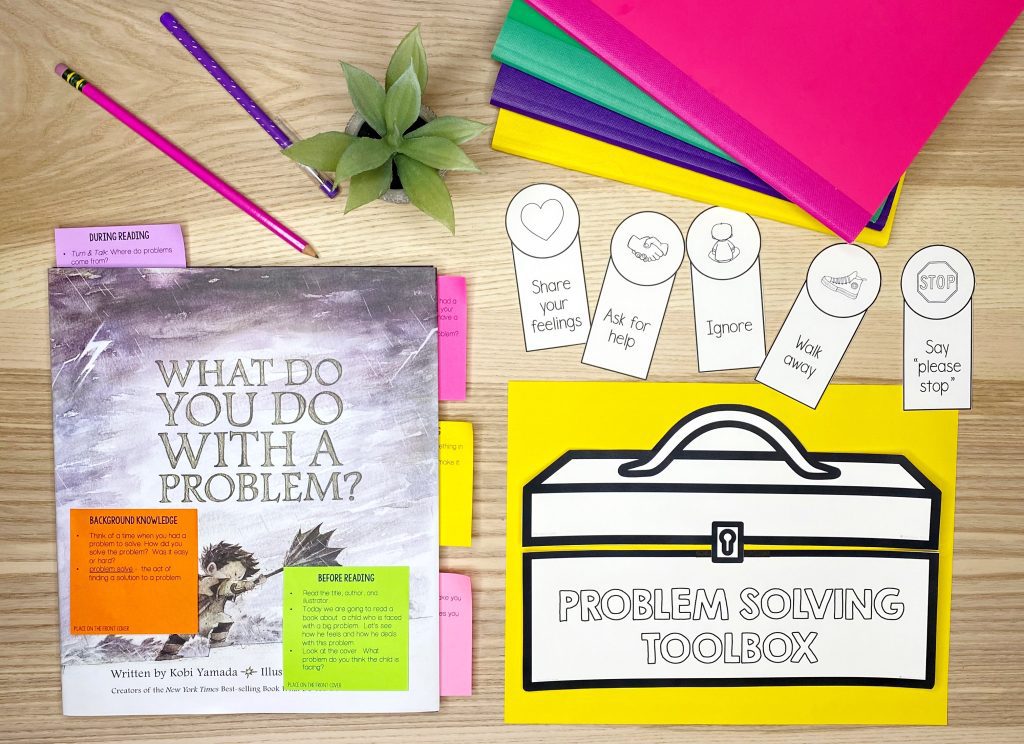
Students experience so many new aspects each day. Between problems on the playground to being unsure of something on an assignment, everything is new at one time. So, this often makes students uncomfortable and worried. Since teachers never want students to feel like this, they work hard at showing there is always support around. For instance, teaching problem solving with What Do You Do With a Problem? is a fantastic book to use! Honestly, this is a tremendous story to show students their never-ending strength! This will help students see that everyone has problems. The importance is never giving up or backing down from the situation.

Between the book and Read Aloud Activities, students will be confident in handling any problem!
What Do You Do With a Problem?
Author Kobi Yamada and illustrator Mae Besom developed the perfect way to teach students about an essential Social Emotional skill!
Students will experience new problems each day. So, this story takes readers on the journey of a child with a persistent problem who isn’t sure what to do. Instead of solving the problem, the child decides to avoid it. However, the problem just gets bigger with each day. Thankfully, the child musters enough courage and confidence to face the dilemma.
Honestly, students of all ages will see how problems can appear much worse than they are!
Read Aloud Activities for Problem Solving
Being unsure of what to do is never a good feeling to have. Since this feeling can be so new to students, they are uncertain about what to do. So, this often results in behavior issues or breakdowns. To avoid this from happening in your classroom, teaching problem solving with What Do You Do With a Problem? is key!
Since teachers have so much to prepare, there is a teacher guide to outline the entire unit. Specifically, this contains all of the lesson plans needed. Additionally, it includes an introduction to help prepare students and sets the purpose for the story. Likewise, it has essential vocabulary words!

When learning how to apply problem solving skills, it is crucial to have a discussion. Therefore, there are higher-level thinking questions and talking points to guide studens. Each question includes a page number, so teachers know exactly where to stop.
While discussion is essential to include in lessons, personal reflection is also critical. Thankfully, teaching problem solving with What Do You Do With a Problem? has both aspects! There is a written response and activity sheet to help students understand different ways to handle an issue. There are even differentiated options to ensure every student knows the importance of this social skill.
Furthermore, there is hands-on craftivity! Students will love how the craft connects the story to their lives.
Problem Solving Application
Teachers work hard to ensure students understand how the material taught in the classroom relates to life outside of school. Therefore, there are task cards that provide scenarios or thought-provoking questions. This helps students apply problem solving strategies to different situations.

There are multiple ways to use the task cards. Honestly, they work great for whole class or small group discussions. They even work perfectly for individual work time.
Problem Solving No Prep Resource
Teachers have to handle so much. Thankfully, the Read Aloud Activities are all no prep! Teachers just need to print the resources.

Students will experience new problems all the time. So, they must learn how to deal with them. Instead of backing away or giving up, they need the skills to tackle them head-on. This is exactly why teaching problem solving with What Do You Do With a Problem? is crucial in all classrooms! Students will be so thankful to learn this essential Social Emotional skill.
Grab this Free Read Aloud
If you do not want to miss any of the upcoming lessons, join my email list to be notified of all the interactive lessons coming up! By joining the email list, you will also receive a FREE Book List for Social Emotional Learning for blog exclusive subscribers!
Save this Read Aloud
Be sure to save this pin to your favorite read alouds board on Pinterest! You’ll be able to come back to this lesson plan when you are ready to read it aloud with your students.
